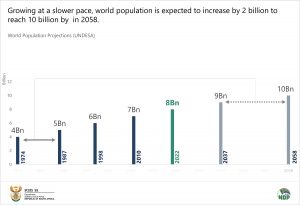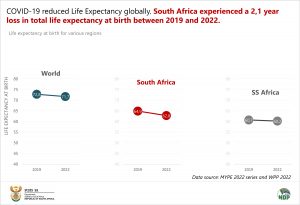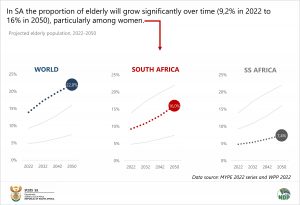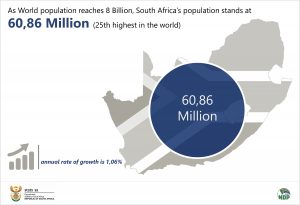THE WORLD AT 8 BILLION
The total population of the world is projected to reach 8 billion on the 15th of November 2022. As the world’s population grew, we have marked the birth of the next billionth person as a milestone and reflected on the progress humanity has made over time, as well as how to improve moving forward.
Similarly, as the population of the world reaches 8 billion, it is important to consider the impacts that this population’s size and its projected growth to 9 billion in 2037 will have on the earth we inhabit, commonly understood as climate change. It is not only the growth of the population per se but rather our use of natural resources (carbon footprint) that is to be monitored over time. According to the International Organisation for Migration (IOM), 1 in 8 persons will be displaced due to climate change globally by 2050. The 27th Climate Change conference (COP27) that took place earlier this month in Egypt is an example of nations coming together in solidarity to contribute to a climate response.
World population growth is led by natural increase. A positive natural increase indicates the greater influence of births relative to deaths. Despite increasing migration across countries, South Africa’s population growth is also driven by natural increase. However, with declining fertility and an increase in deaths post COVID-19 (34% in 2021), the rate of natural increase in South Africa dropped from 11 persons per 1 000 population in 2020 to 8 persons per 1 000 population in 2022.
On 5 March 2020, South Africa recorded its first case of COVID-19. By the 11th of March, the World Health Organization (WHO) declared COVID-19 a global pandemic. South Africa’s first COVID-19 related death occurred on 27 March 2020. The global COVID-19 pandemic impacted countries with ageing populations more drastically. Older people and those with co-morbidities, specifically diabetes and hypertension, face a higher risk of mortality. However, broader categories of respiratory diseases, circulatory diseases and cancer also face a higher risk of mortality.
The age and sex structure of the population had a significant role to play in the impact of the COVID-19 pandemic. As the spread of the disease occurred over time, there was a rise in the number of direct and indirect deaths in the population due to COVID-19. In conjunction, there was a rise in innovation in COVID-19 related treatment protocols, prevention measures and vaccination development over this time. The life expectancy at birth globally reduced from 72,8 years in 2019 to 71,7 years in 2022, while life expectancy in South Africa reduced from 64,9 in 2019 to 62,8 in 2022. The COVID-19 pandemic required leaders from all over the world and global organisations to work together to address not only the devastation of the COVID-19
pandemic, but assist with preparedness for future outbreaks.
Despite increased deaths due to COVID-19 in the past 3 years, declining fertility and increased life expectancy over decades is projected to result in a greying of the population globally by 2050. Between 2022 and 2050 the proportion of the elderly (aged 60+) in the world will grow from 14% to 22%. However, the proportion of the elderly varies significantly from region to region and country to country. In 2022 the proportion of the elderly in Japan is estimated at 36%, whilst in Uganda the elderly account for just 3% of the population.
South Africa is one of the few developing countries experiencing a significant increase in the proportion of persons aged 60 and over, estimated to increase from 9,2% in 2002 to 16,0% in 2050. The growing proportion of elderly persons in South Africa will bring new challenges. Aging populations often experience old-age dependency, social and economic vulnerability, and increased strain on health and social care.
The occasion of reaching a population milestone of 8 billion is a moment for reflection on the fertility and mortality trajectories of countries all over the world, and to determine to what extent governments and other organisations can potentially impact those trajectories for their betterment. Whilst some nations experience continued increased population growth, we need to be able to detach this growth from potential negative impact on sustainable development goals aspired to. The world reaching another billion is a reminder to governments, policy makers, and international bodies to ensure dignified and fulfilled lives for all 8 billion people. South Africa is projected to reach a population of 70 million in 2035. Such a milestone should be used as a catalyst for pursuing economic and social investments so as to improve the lives of every South African.
For more information on population changes in South Africa, visit www.statssa.gov.za.





